BMW M6 CONVERTIBLE 2002 Owners Manual
Manufacturer: BMW, Model Year: 2002, Model line: M6 CONVERTIBLE, Model: BMW M6 CONVERTIBLE 2002Pages: 186, PDF Size: 2.77 MB
Page 161 of 186
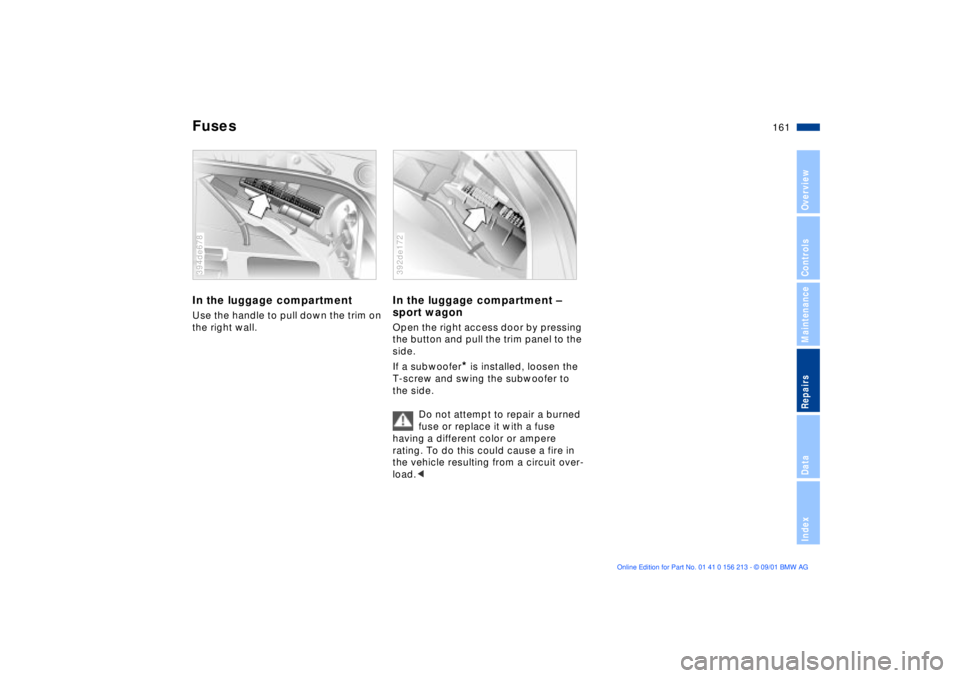
161n
OverviewControlsMaintenanceRepairsDataIndex
FusesIn the luggage compartmentUse the handle to pull down the trim on
the right wall.394de678
In the luggage compartment Ð
sport wagonOpen the right access door by pressing
the button and pull the trim panel to the
side.
If a subwoofer
* is installed, loosen the
T-screw and swing the subwoofer to
the side.
Do not attempt to repair a burned
fuse or replace it with a fuse
having a different color or ampere
rating. To do this could cause a fire in
the vehicle resulting from a circuit over-
load.<
392de172
Page 162 of 186
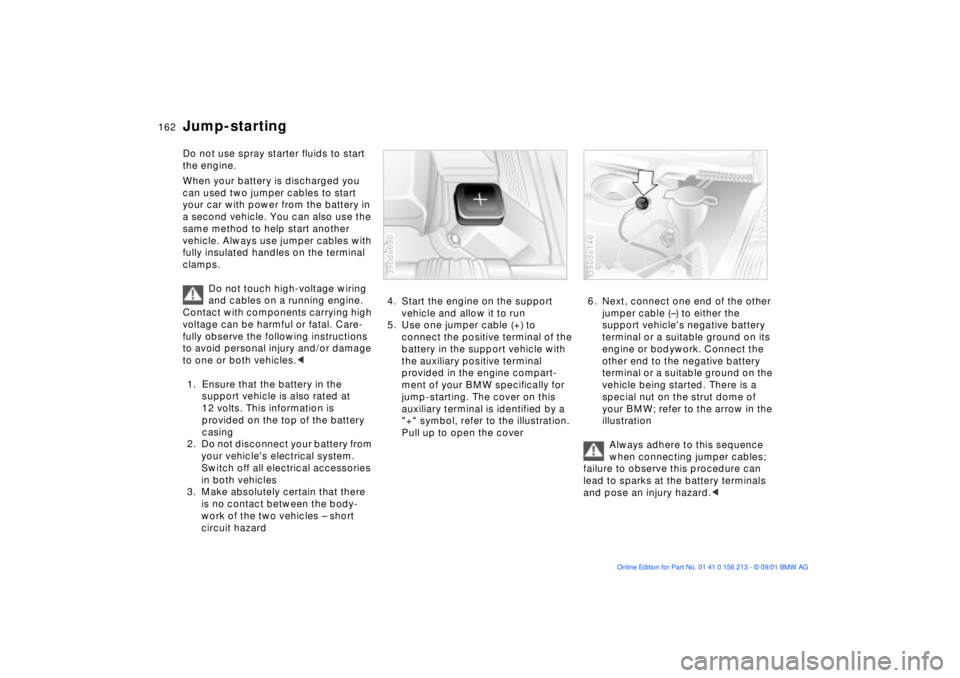
162n
Do not use spray starter fluids to start
the engine.
When your battery is discharged you
can used two jumper cables to start
your car with power from the battery in
a second vehicle. You can also use the
same method to help start another
vehicle. Always use jumper cables with
fully insulated handles on the terminal
clamps.
Do not touch high-voltage wiring
and cables on a running engine.
Contact with components carrying high
voltage can be harmful or fatal. Care-
fully observe the following instructions
to avoid personal injury and/or damage
to one or both vehicles.<
1. Ensure that the battery in the
support vehicle is also rated at
12 volts. This information is
provided on the top of the battery
casing
2. Do not disconnect your battery from
your vehicle's electrical system.
Switch off all electrical accessories
in both vehicles
3. Make absolutely certain that there
is no contact between the body-
work of the two vehicles Ð short
circuit hazard
4. Start the engine on the support
vehicle and allow it to run
5. Use one jumper cable (+) to
connect the positive terminal of the
battery in the support vehicle with
the auxiliary positive terminal
provided in the engine compart-
ment of your BMW specifically for
jump-starting. The cover on this
auxiliary terminal is identified by a
"+" symbol, refer to the illustration.
Pull up to open the cover390de690
6. Next, connect one end of the other
jumper cable (Ð) to either the
support vehicle's negative battery
terminal or a suitable ground on its
engine or bodywork. Connect the
other end to the negative battery
terminal or a suitable ground on the
vehicle being started. There is a
special nut on the strut dome of
your BMW; refer to the arrow in the
illustration
Always adhere to this sequence
when connecting jumper cables;
failure to observe this procedure can
lead to sparks at the battery terminals
and pose an injury hazard.< 390de146
Jump-starting
Page 163 of 186
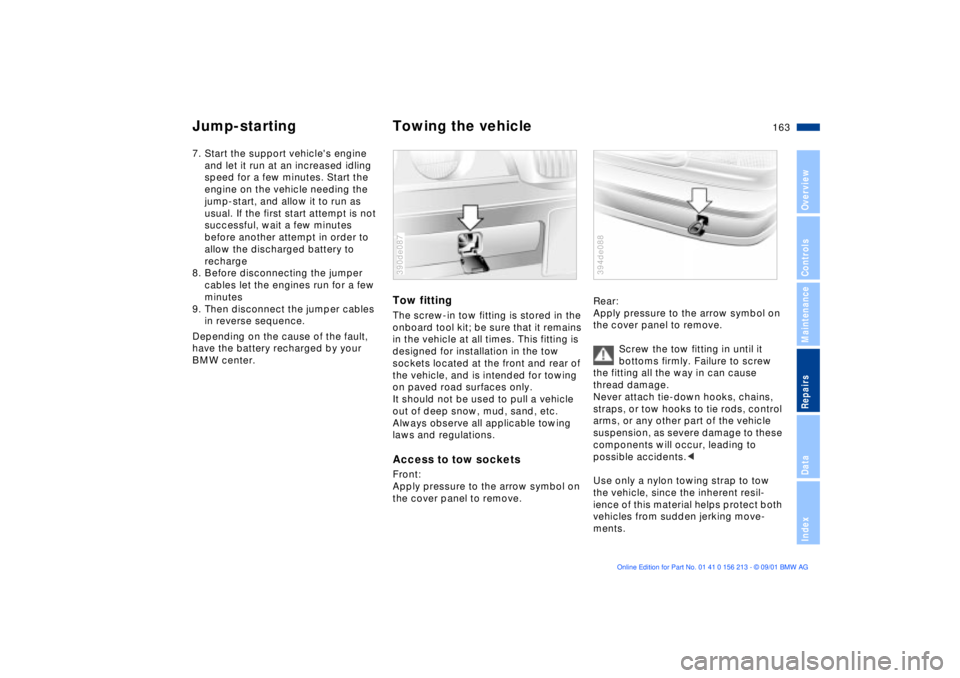
163n
OverviewControlsMaintenanceRepairsDataIndex
Jump-starting Towing the vehicle7. Start the support vehicle's engine
and let it run at an increased idling
speed for a few minutes. Start the
engine on the vehicle needing the
jump-start, and allow it to run as
usual. If the first start attempt is not
successful, wait a few minutes
before another attempt in order to
allow the discharged battery to
recharge
8. Before disconnecting the jumper
cables let the engines run for a few
minutes
9. Then disconnect the jumper cables
in reverse sequence.
Depending on the cause of the fault,
have the battery recharged by your
BMW center.
Tow fittingThe screw-in tow fitting is stored in the
onboard tool kit; be sure that it remains
in the vehicle at all times. This fitting is
designed for installation in the tow
sockets located at the front and rear of
the vehicle, and is intended for towing
on paved road surfaces only.
It should not be used to pull a vehicle
out of deep snow, mud, sand, etc.
Always observe all applicable towing
laws and regulations.Access to tow socketsFront:
Apply pressure to the arrow symbol on
the cover panel to remove.390de087
Rear:
Apply pressure to the arrow symbol on
the cover panel to remove.
Screw the tow fitting in until it
bottoms firmly. Failure to screw
the fitting all the way in can cause
thread damage.
Never attach tie-down hooks, chains,
straps, or tow hooks to tie rods, control
arms, or any other part of the vehicle
suspension, as severe damage to these
components will occur, leading to
possible accidents.<
Use only a nylon towing strap to tow
the vehicle, since the inherent resil-
ience of this material helps protect both
vehicles from sudden jerking move-
ments.394de088
Page 164 of 186
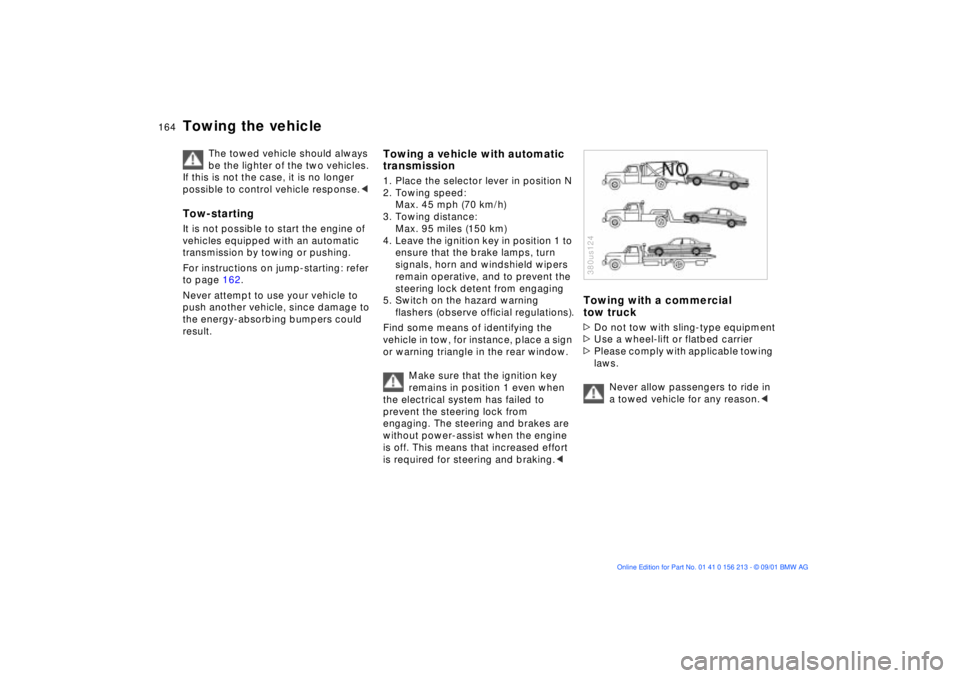
164n
Towing the vehicle
The towed vehicle should always
be the lighter of the two vehicles.
If this is not the case, it is no longer
possible to control vehicle response.<
Tow-startingIt is not possible to start the engine of
vehicles equipped with an automatic
transmission by towing or pushing.
For instructions on jump-starting: refer
to page 162.
Never attempt to use your vehicle to
push another vehicle, since damage to
the energy-absorbing bumpers could
result.
Towing a vehicle with automatic
transmission1. Place the selector lever in position N
2. Towing speed:
Max. 45 mph (70 km/h)
3. Towing distance:
Max. 95 miles (150 km)
4. Leave the ignition key in position 1 to
ensure that the brake lamps, turn
signals, horn and windshield wipers
remain operative, and to prevent the
steering lock detent from engaging
5. Switch on the hazard warning
flashers (observe official regulations).
Find some means of identifying the
vehicle in tow, for instance, place a sign
or warning triangle in the rear window.
Make sure that the ignition key
remains in position 1 even when
the electrical system has failed to
prevent the steering lock from
engaging. The steering and brakes are
without power-assist when the engine
is off. This means that increased effort
is required for steering and braking.<
Towing with a commercial
tow truck>Do not tow with sling-type equipment
>Use a wheel-lift or flatbed carrier
>Please comply with applicable towing
laws.
Never allow passengers to ride in
a towed vehicle for any reason.< 380us124
Page 165 of 186
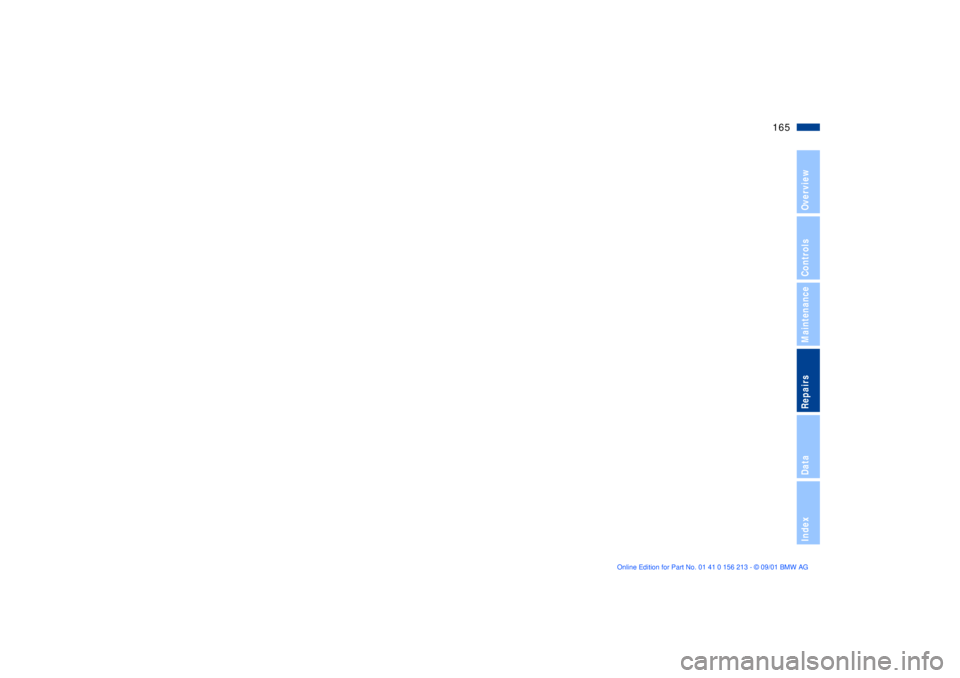
165n
OverviewControlsMaintenanceRepairsDataIndex
Page 166 of 186
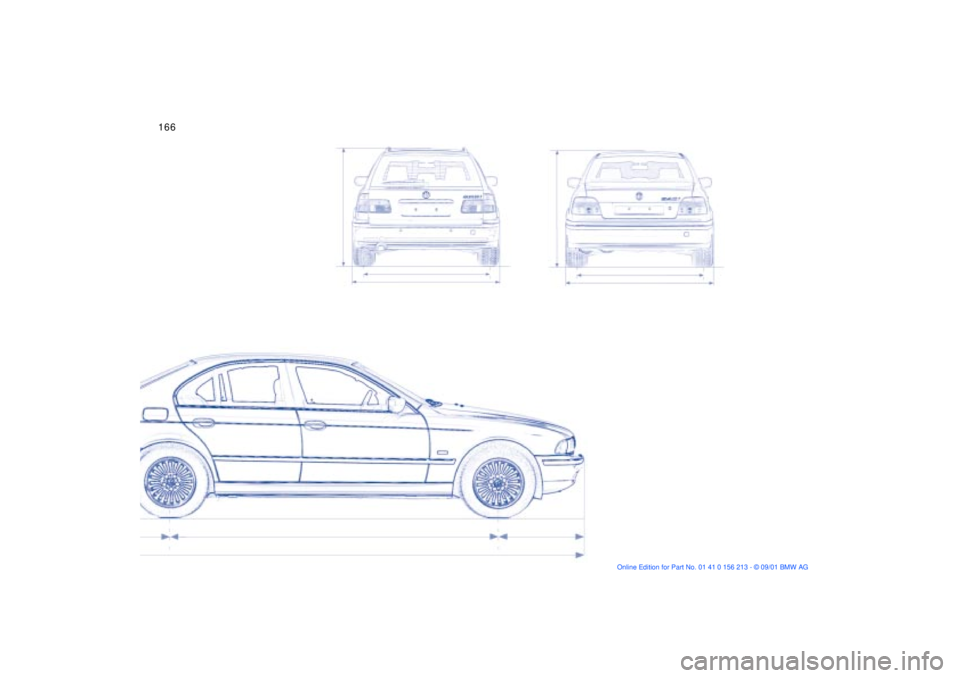
166n
Page 167 of 186
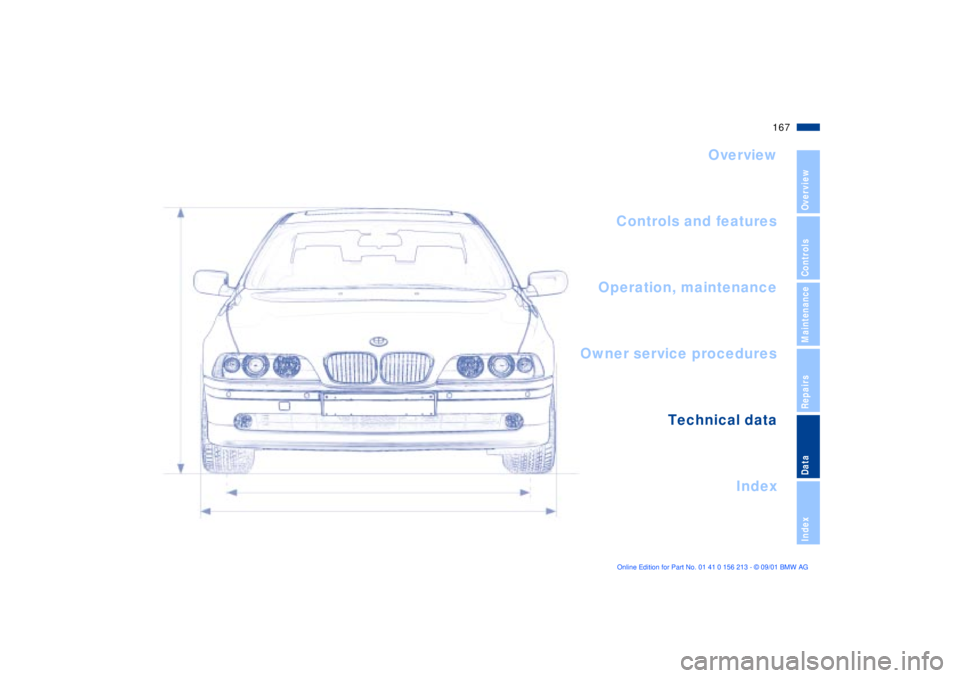
167n
OverviewControlsMaintenanceRepairsDataIndex
Overview
Controls and features
Operation, maintenance
Owner service procedures
Index Technical data
Index
Page 168 of 186
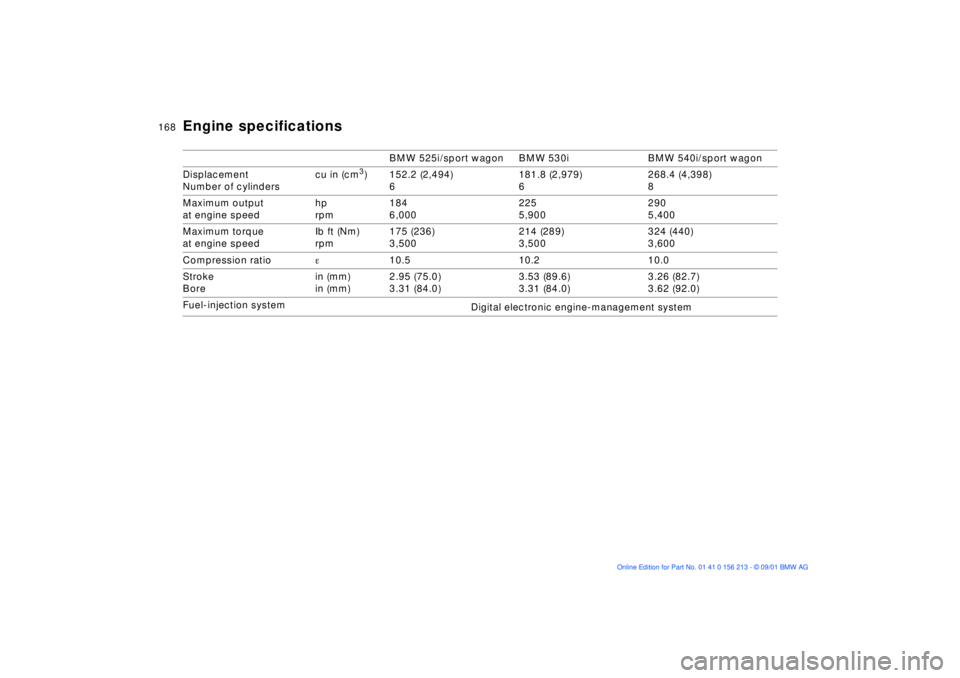
168n
BMW 525i/sport wagon BMW 530i BMW 540i/sport wagon
Displacement
Number of cylinderscu in (cm
3) 152.2 (2,494)
6181.8 (2,979)
6268.4 (4,398)
8
Maximum output
at engine speedhp
rpm184
6,000225
5,900290
5,400
Maximum torque
at engine speedIb ft (Nm)
rpm175 (236)
3,500214 (289)
3,500324 (440)
3,600
Compression ratioe10.5 10.2 10.0
Stroke
Borein (mm)
in (mm)2.95 (75.0)
3.31 (84.0)3.53 (89.6)
3.31 (84.0)3.26 (82.7)
3.62 (92.0)
Fuel-injection system
Digital electronic engine-management system
Engine specifications
Page 169 of 186
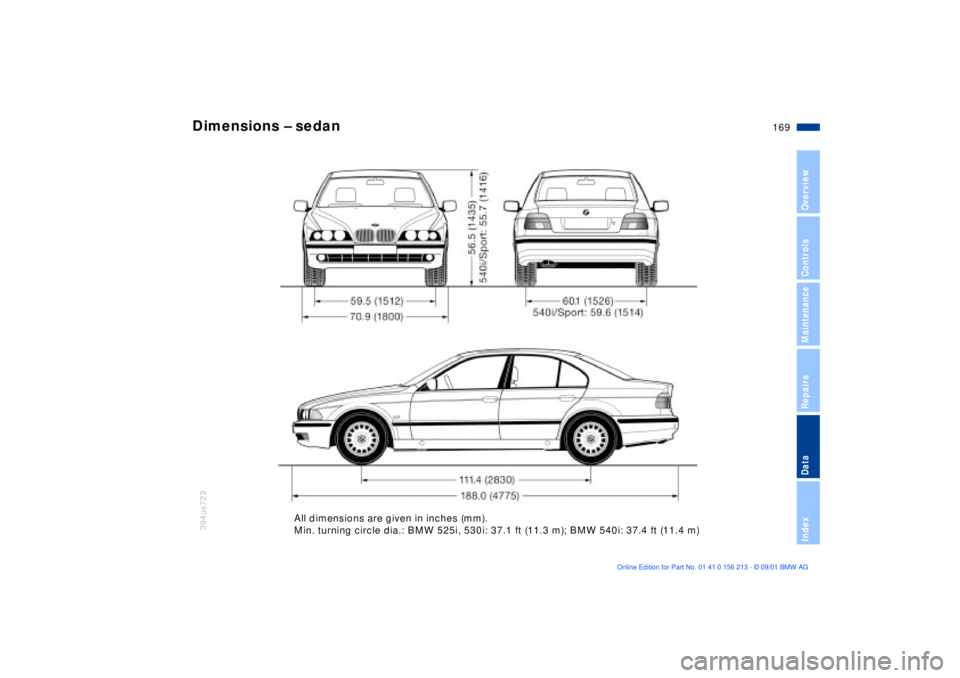
169n
OverviewControlsMaintenanceRepairsDataIndex
394us723
Dimensions Ð sedan
All dimensions are given in inches (mm).
Min. turning circle dia.: BMW 525i, 530i: 37.1 ft (11.3 m); BMW 540i: 37.4 ft (11.4 m)
Page 170 of 186
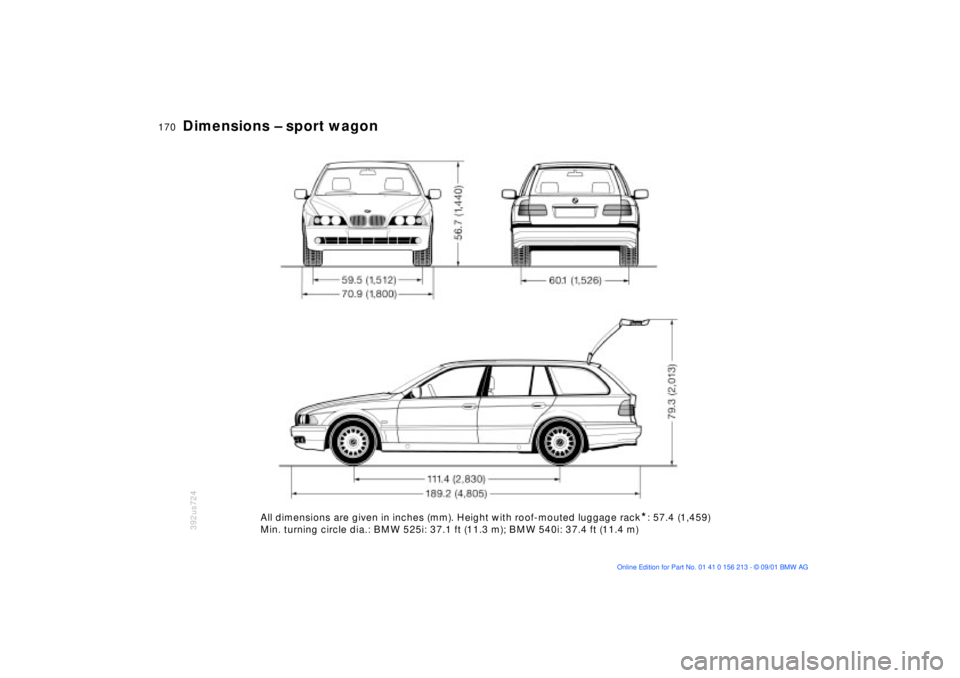
170n
Dimensions Ð sport wagon
392us724
All dimensions are given in inches (mm). Height with roof-mouted luggage rack
*: 57.4 (1,459)
Min. turning circle dia.: BMW 525i: 37.1 ft (11.3 m); BMW 540i: 37.4 ft (11.4 m)